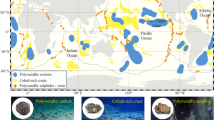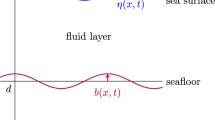Abstract
Submarine sand waves, vital to seabed stability, are an important consideration for oceanic engineering projects such as oil pipe lines and submarine cables. The properties of surface sediment and the evolvement of submarine sand waves in a specified area in the South China Sea are studied using both a hydrological model and field observational data. The bottom flow field data between 2010 and 2011 in the study area are simulated by the Regional Ocean Model System (ROMS). The migration of submarine sand waves is calculated using Rubin’s formula along with typhoon data and bottom flow field data, which allows for the analysis of sand wave response under the influence of typhoons. The migration direction calculated by Rubin’s formula and bottom flow are very similar to collected data. The migration distance of different positions is between 0.0 m and 21.8 m, which reciprocates cumulatively. This shows that Rubin’s formula can predict the progress of submarine sand waves with the bottom flow simulated by ROMS. The migration distances of 2 sites in the study area are 2.0 m and 2.9 m during the typhoon “Fanapi”. The proportion of the calculated migration distance by the typhoon is 9.17% and 26.36% of the annual migration distance, respectively, which proves that the typhoon can make a significant impact on submarine sand waves.
Similar content being viewed by others
References
Anthony D, Leth J O (2002). Large-scale bedforms, sediment distribution and sand mobility in the eastern North Sea off the Danish west coast. Mar Geol, 182(3-4): 247–263
Ashley G M (1990). Classification of large-scale subaqueous bedforms: a new look at old problem. J Sediment Petrol, 60(1): 160–172
Bai Y C, Yang X G, Tian Q, Zhang B (2009). Evolution characteristics of seabed sand wave in Northern South China Sea. J Hydraul Eng, 40(8): 941–955
Budgell W (2005). Numerical simulation of ice-ocean variability in the Barents Sea region. Ocean Dyn, 55(3-4): 370–387
Camenen B, Larson M (2005). A general formula for non-cohesive bed load sediment transport. Estuarine, Coastal and Shelf Science, 63(1–2): 249–260
Dalrymple R W, Hoogendoorn E L (1997). Erosion and deposition on migrating shoreface-attached ridges, Sable Island, eastern Canada. Geoscience Canada, 24(1): 25–36
Di Lorenzo E (2003). Seasonal dynamics of the surface circulation in the Southern California Current System. Deep Sea Res Part II Top Stud Oceanogr, 50(14–16): 2371–2388
Dinniman M S, Klinck J M, Smith W O (2003). Cross-shelf exchange in a model of the Ross Sea circulation and biogeochemistry. Deep Sea Res Part II Top Stud Oceanogr, 50(22–26): 3103–3120
Dong C M, Idica E Y, McWilliams J C (2009). Circulation and multiplescale variability in the Southern California Bight. Prog Oceanogr, 82(3): 168–190
Dong Z H (2006). The influence on current ridge, sand wave and topography of Dongfang offshore by typhoon. Dissertation for Master Degree. Qing Dao: Ocean University of China
Egbert G D, Bennett A F, Foreman M G (1994). TOPEX/POSEIDON tides estimated using a global inverse model. J Geophys Res, 99 (C12): 24821–24852
Egbert G D, Erofeeva S Y (2002). Efficient inverse modeling of barotropic ocean tides. J Atmos Ocean Technol, 19(2): 183–204
Feng W K, Li W F, Shi Y H (1994). Dynamic study on sand wave geomorphology in Northern South China Sea. Acta Oceanol Sin, 16(6): 92–99
Gao S, Collins M B (1997). Changes in sediment transport rates caused by wave action and tidal flow time-asymmetry. J Coast Res, 13(1): 198–201
Haidvogel D B, Arango H G, Hedstrom K, Beckmann A, Malanotte-Rizzoli P, Shchepetkin A F (2000). Model evaluation experiments in the North Atlantic Basin: simulations in nonlinear terrain-following coordinates. Dyn Atmos Oceans, 32(3): 239–281
Hu R J (2006). Dynamical analysis of seafloor sandwaves in the outer continental shelf of the Northern South China Sea. Dissertation for Master Degree. Qing Dao: Ocean University of China
Kennedy A B, Slatton K C, Hsu T, Starek M J, Kampa K (2008). Ephemeral sand waves in the hurricane surf zone. Mar Geol, 250(3–4): 276–280
Knaapen M A F (2005). Sandwave migration predictor based on shape information. J Geophys Res, 110(F4): F04S11
Li Y, Lin M, Jiang W B, Fan F (2011). Process control of the sand wave migration in Beibu Gulf of the South China Sea. Journal of Hydronamics, 23(4): 439–446
Li Z W (2011). Research on hazardous geological factors in the outer shelf of Northern South China Sea and influence on the submarine pipelines. Dissertation for Master Degree. Qing Dao: Institute of Oceanology, Chinese Academy of Sciences
Lin M, Fan F X, Li Y, Yan J, Jiang W B, Gong D J (2009). Observation and theoretical analysis for the sand-waves migration in the North Gulf of South China Sea. Chin J Geophys, 52(3): 776–784
Liu X H, Dong C, Chen D, Su J (2014). The pattern and variability of winter Kuroshio intrusion northeast of Taiwan. Journal of Geophysical Research: Oceans, 119(8): 5380–5394
Luan XW, Peng X C, Wang Y M, Qiu Y (2010). Characteristics of sand waves on the Northern South China Sea Shelf and its formation. Acta Geol Sin, 84(2): 233–245
Ludwiek J C (1970). Sand waves in the tidal entrance to Chesapeake Bay preliminary observations. Chesapeake Science, 11(2): 98–110
Ma X C (2013). Formation, evolution and engineering significance of submarine sand waves and sand ridges, southeast of Hainan Island. Dissertation for Docter Degree. Qingdao: Institute of Oceanology, Chinese Academy of Sciences
Marchesiello P, McWilliams J C, Shchepetkin A (2003). Equilibrium structure and dynamics of the California Current System. J Phys Oceanogr, 33(4): 753–783
McBride R A, Moslow T F (1991). Origin, evolution and distribution of shoreface sand ridges, Atlantic inner shelf, U.S.A. Mar Geol, 97(1-2): 57–85
Peliz Á, Dubert J, Haidvogel D B, Cann B L (2003). Generation and unstable evolution of a density-driven eastern poleward current: the Iberian Poleward Current. J Geophys Res, 108(C8): 3268
Perillo G M E, Ludwick J C (1994). Geomorphology of a sand wave in lower Chesapeake Bay, Virginia, U.S.A.. Geo-Marine Letters, 4(2): 105–112
Ribberink J S (1998). Bed-load transport for steady flows and unsteady oscillatory flows. Coastal Engineering, 34(1-2): 59–82
Rubin DM, Hunter R E (1982). Bedforms climbing in theory and nature. Sedimentology, 29(1): 121–138
Saha S, Moorthi S, Pan H L, Wu X, Wang J, Nadiga S, Tripp P, Kistler R, Woollen J, Behringer D, Liu H, Stokes D, Grumbine R, Gayno G, Wang J, Hou Y T, Chuang H Y, Juang H M H, Sela J, Iredell M, Treadon R, Kleist D, Van Delst P, Keyser D, Derber J, Ek M, Meng J, Wei H, Yang R, Lord S, Van Den Dool H, Kumar A, Wang W, Long C, Chelliah M, Xue Y, Huang B, Schemm J K, Ebisuzaki W, Lin R, Xie P, Chen M, Zhou S, Higgins W, Zou C Z, Liu Q, Chen Y, Han Y, Cucurull L, Reynolds R W, Rutledge G, Goldberg M (2010). The NCEP climate forecast system reanalysis. Bull Am Meteorol Soc, 91(8): 1015–1057
Santoro V C, Amore E, Cavallaro L, De Lauro M (2004). Evolution of sand waves in the Messina Strait, Italy. Ocean Dyn, 54(3–4): 392–398
Swift D J P, Field M E (1981). Evolution of a classic sand ridge field: Maryland sector, North American inner shelf. Sedimentology, 28(4): 461–482
Van Rijn L C (1993). Principles of Sediment Transport in Rivers, Estuaries and Coastal Seas. Aqua Publications–I11, Amsterdam, The Netherlands
Wang S Y, Li D M (1994). Dynamic analysis on sand waves in continental shelf slope and continental slope of Pearl River Mouth Basin in South China Sea. Acta Oceanol Sin, 16(6): 122–132
Wang W W, Yan J, Fan F X (2007). The research situation of bed-form stability influenced by seabed sand wave migration under wave combined current conditions. Mark Sci, 31(3): 89–93
Warner J C, Geyer WR, Lerczak J A (2005a). Numerical modeling of an estuary: a comprehensive skill assessment. J Geophys Res, 110(C5): C05001
Warner J C, Sherwood C R, Arango H G, Signell R P (2005b). Performance of four turbulence closure models implemented using a generic length scale method. Ocean Model, 8(1–2): 81–113
Wilkin J L, Arango H G, Haidvogel D B, Lichtenwalner C, Glenn S M, Hedström K S (2005). A regional ocean modeling system for the Long-term Ecosystem Observatory. J Geophys Res, 110(C6): C06S91
Xia D X, Wu S Y, Liu Z X, Yin P, Qi F Q, Ye Y C, Xie Q C, Chen X T, Lai X H, Chen X L (2001). Research on the activity of submarine sand waves off Dongfang, Hainan Island. Journal of Oceanography of Huanghai & Bohai Seas, 19(l): 17–24 (in Chinese)
Zhou C (2013). A study on the distribution and activity mechanism of sand waves on the Northern South China Sea Shelf. Dissertation for Master Degree. Qingdao: Institute of Oceanology, Chinese Academy of Sciences
Acknowledgements
This study is supported by the Marine Public Welfare Industry Program of State Oceanic Administration (Grant No. 201005005). Yan LI from the First Institute of Oceanography, SOA, is appreciated for her work on partial calculations. Dr. Yu LIU, School of Marine Sciences, Nanjing University of Information Science & Technology, is appreciated for his valuable help in coordinating the running of ROMS. Thanks to Philipp Wu from the University of California, Berkeley for his help in proofreading the manuscript. CD appreciates the support from the National Natural Science Foundation of China (Grant Nos. 41476022, 41490643, and 91128204), Startup Foundation for Introducing Talent of Nanjing University of Information Science & Technology (2013r121 and 2014r072), Program for Innovation Research and Entrepreneurship team in Jiangsu Province, National Basic Research Program of China (No. 2014CB745000), and National Programme on Global Change and Air-Sea Interaction (No. GASI- 03-IPOVAI-05).
Author information
Authors and Affiliations
Corresponding author
Rights and permissions
About this article
Cite this article
Zhou, Q., Hu, G., Sun, Y. et al. Numerical research on evolvement of submarine sand waves in the Northern South China Sea. Front. Earth Sci. 11, 35–45 (2017). https://doi.org/10.1007/s11707-016-0571-6
Received:
Accepted:
Published:
Issue Date:
DOI: https://doi.org/10.1007/s11707-016-0571-6




